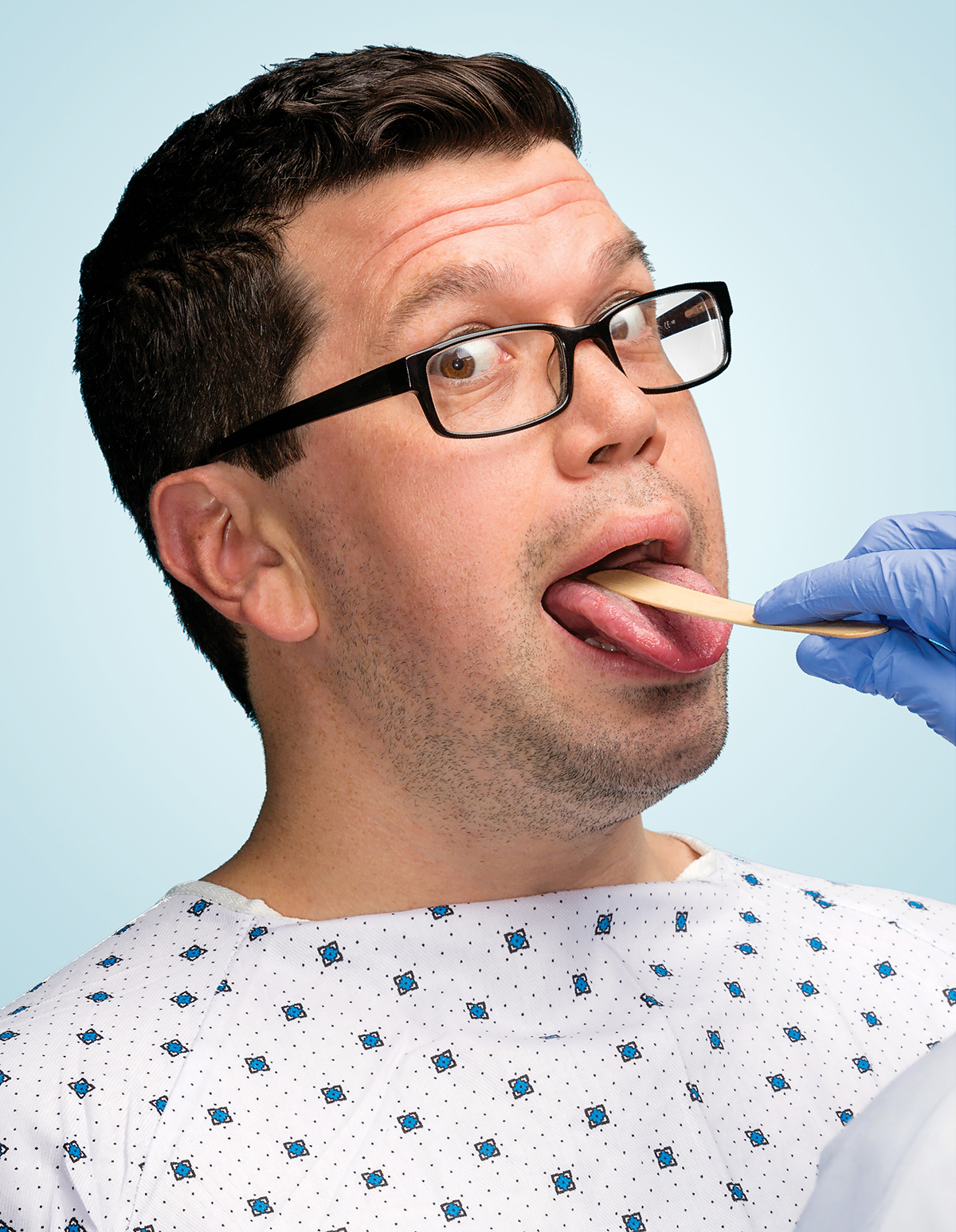I Wanted Eternal Life

Boston magazine staff writer Chris Sweeney. / Photograph by Jason Grow
One night this past summer, I decided I didn’t want to die. Don’t worry. I’m not infected with a deadly pathogen, and as far as I know there are no cancerous cells massing inside of me. No, the urge to indefinitely extend my stay on Earth was rooted in a moment of pure bliss: My wife peed on a pregnancy test and the result came up positive. The wellspring of joy that followed soon gave way to the OMFG realization that—despite how invincible I may feel after downing a six-pack—I am a mere mortal who can be struck down at any point.
To instantly improve my chances of survival, my gut instinct led me to go online and order a bike helmet, something I should have done years ago. It turns out that my looking like a safety-conscious geek brings significant peace of mind to both my wife and me. Other than reducing the chances of my brain splattering on the pavement during the morning commute, though, I didn’t know what else I was supposed to do. I’m 33. I exercise. My diet is decent, and I’ve never had any major health issues. Of course, family history plays a big role in all of this, and there, I’m a grab bag of genetics. My dad’s mom developed Alzheimer’s disease at 63 and died at 69. My maternal great-grandmother, on the other hand, subsisted on meat and potatoes and peanut M & Ms and lasted nearly 105 years.
It’s not surprising, of course, that creating a new life makes my own inevitable end feel more concrete. On a typical day-to-day and year-to-year basis, aging is an abstraction: From the moment the egg is fertilized, there is never a point in life at which we stop getting older. Yet time is so subtle that it can seem nearly imperceptible. Sure, a few aches and pains or wrinkles come into play, but it’s not like you go to bed on your 40th birthday and wake up a crotchety sack of liver spots. On the long, slow road to growing old, major events like a pregnancy or the loss of a parent serve as important mileposts that remind us where we’ve been and show us where we’re going.
The more I chewed it over, though, the distinction between aging and dying became blurrier. After all, it is accurate to define aging as one of the biggest risk factors for an assortment of potentially fatal ailments. Alzheimer’s, Parkinson’s, heart disease, cancer, stroke—the older you get, the more likely it is that you’ll be affected by one of these killers. In that regard, aging is fast becoming a public health crisis. The number of Americans over the age of 85 is expected to increase by 350 percent from 2000 to 2050, and there will be almost 84 million of us older than 65 halfway through this century. These dramatic demographic shifts are poised to disrupt just about every facet of American life, yet our federal government spends only $3.67 per person on aging research.
That said, I’m bullish on advances in medicine. It’s hard not to be when you live here. Within 2 square miles of my apartment in Cambridge are labs that belong to the pharmaceutical powerhouses Novartis, Pfizer, Sanofi, and Takeda, not to mention the campuses of MIT and Harvard. Just across the Charles are hospitals regularly pulling off miracles, engineers building artificial organs, and evolutionary biologists contending that there is no theoretical limit to how long a human cell can live.
In an attempt to stack the odds of survival firmly in my favor, I spent a few days playing Juan Ponce de León, chasing down the foremost doctors and scientists in hopes of figuring out how we age, why we die, and how to cheat the system. Spoiler alert: I didn’t find the Fountain of Youth. But what I discovered has proven far more valuable.
In the grand scheme of things, getting old is a shockingly new experience. So explains Shalender Bhasin as he sits behind foot-high stacks of paper in his office at Brigham and Women’s Hospital. “Of the 10,000 generations of men and women who have lived on this planet, only the men and women of the last three generations could have hoped to live past their reproductive years,” says Bhasin, who serves as the director of the hospital’s Claude D. Pepper Older Americans Independence Center. “Aging is a very recent and powerful event.”
At the turn of the 20th century, he explains, life expectancy was somewhere in the thirties. War, famine, pestilence, mosquito-borne diseases, and parasite-ridden water put enormous pressure on our ancestors’ chances of survival. Then, in the span of a mere 200 years or so, we made huge strides in sanitation systems, developed vaccines and antibiotics, forged peace pacts, conquered nature, and revolutionized agriculture. Today, Bhasin says, “Men and women are expected to spend half of their life past their primary reproductive years.”
So the good news is that we’re living longer than ever—in the United States, the average life expectancy is now 78.8 years. The bad news is that the years we’ve managed to add on to the tail end of life can be the physiological equivalent of garbage time during a Patriots blowout, and our bodies are on the losing end. As we age, many of us end up dealing with a compounding effect of bad health, or what doctors call comorbidities. A hip fracture at age 80, for instance, might exacerbate a chronic disease such as diabetes, which a few months later could result in an extended hospital stay that exposes you to pneumonia or a drug-resistant staph infection. As the saying goes: When it rains, it pours.
Unfortunately, it’s a trajectory too many of us will follow, making the delivery of care more complex—and more expensive. “So much of our healthcare expenditure is being devoted to caring for people during that rapid phase of decline,” Bhasin says. “I’m not sure we’re doing a lot of societal good or individual good.”
Part of the problem is a health system—from how doctors are trained to how hospitals are reimbursed—that favors prolonging life to a fault. Our behavior, though, also plays a big role. As patients, we tend to run away from discussions about aging and dying until we have the proverbial gun to our head and tensions are highest. Aging is framed as a battle, and the ammunition is anti-aging creams, youth-promoting supplements, and prescription pills that strike at the symptoms of bad health but not the root causes.
Bhasin, for his part, recommends a shift in mindset across the board. Rather than continuing to fixate on extending our lifespans, we should focus on ways to extend our health spans and live more meaningfully, however you choose to define that. It seems similar to what most of us want, anyway: The Pew Research Center surveyed more than 2,000 Americans a few years ago and found that only 9 percent of them would choose to live past the age of 100.
So is there a good time to die? The folks surveyed by the Pew study seemed to think so: The majority wanted to live between 79 and 100 years, with 90 being the most desired age on average to perish.
Exiting Earth after 90 years seems like a fair deal. Here’s the catch: After listening to Bhasin, I want 89.9 of those years to be spent in good health. Rather than ticking slower and slower toward death like a cheap wristwatch, I want to naturally explode off the wall and shatter into a million pieces like a cuckoo clock gone haywire when the hour hand strikes midnight.
It may sound like a ludicrous demand, but it’s not entirely baseless. There is growing interest from scientists of all stripes in finding a way to compress those nasty comorbidities and disabilities that come with aging into a shorter period of time toward the end of life. Recent studies have yielded radical extensions of lifespan and health span in lab animals. Getting there in humans, however, isn’t going to be easy, and it requires us to consider how our species made it this far in the first place. “The reason we age is not because we have genes in us programmed to drive aging,” says William Mair, an assistant professor of genetics and complex diseases at Harvard’s School of Public Health. “Aging is fundamentally a side effect of other things that we’ve evolved to have.”
In other words, over the course of humanity’s evolution, we favored fitness, vigor, speed, and strength—qualities that allowed us to thrive when it was time to chase down a deer for dinner. The genes that conferred these traits and allowed our ancient ancestors to survive could also have been associated with chronic diseases and cognitive decay later in life, but it didn’t matter because nobody was around long enough to suffer from them. “It’s survival of the fittest, not survival of the oldest,” Mair quips.


